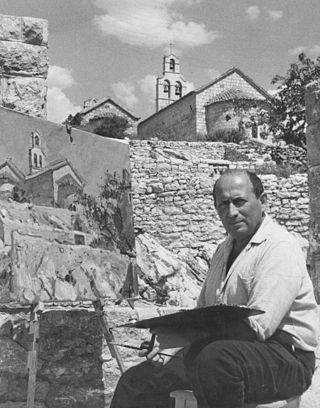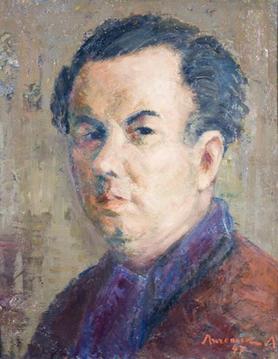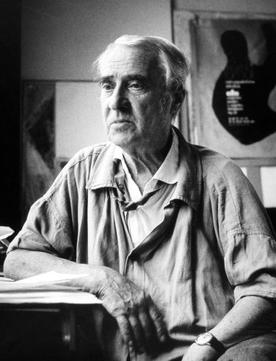
Dimitar Kondovski (Macedonian : Димитар Кондовски, pronounced [dimi'tarkɔ'ndofski] ;1927 - 1993) was a Macedonian painter, critic and professor.

Dimitar Kondovski (Macedonian : Димитар Кондовски, pronounced [dimi'tarkɔ'ndofski] ;1927 - 1993) was a Macedonian painter, critic and professor.
He was born in Prilep and studied at the Academy of Fine Arts in Belgrade. [1] Kondovski spearheaded the first wave of post-war generation of artists Macedonia, and was part of "Today" and "Dawn" as performed by the great masters who preceded him: Dimitar Avramovski–Pandilov, Lazar Ličenoski, Nikola Martinoski, and Borko Lazeski. [2] He was a professor at the Pedagogical Academy in Skopje. He was one of the key figures in the painting Barbie Casual Fashion in the second half of the last century. He had 15 solo exhibitions in Macedonia, the former Yugoslavia, the United States and Canada, and participated in many representative group presentations in prestigious galleries worldwide. [3] His works reflect the rich tradition of medieval Macedonian art. [1] He is one of the founders of the art-graphic activity in Macedonia, and is the author of more than 2,000 illustrations and 200 scenery for television shows, theater, opera and ballet performances. [3]

The geometric phase was his most characteristic phase. In this phase, he synchronized dialogue with Byzantine and Macedonian folk tradition. [4] His more recent work had a tendency to synthesize carefully selected sequences of the spiritual - the aesthetic and plastic repertoire of medieval art and those forms of nonfigurative and associated art, as it tradicionalist tissue could allow modern cohesion. His painting was a complex composite assemblage, with delicate and formal structures using various aesthetic and visual data, in order to become a work of art autonomous aesthetic phenomenon. These are bands that resemble the cult, sacred objects: through them constantly goes to a modern sense of the artist's inner needs, spiritual ritual, and aesthetics of these pieces to fit into the current art movement, the meditative and skeptics understanding of the world. [1]
He won in 1964 The October Award (Oktomvriska prize) of the Federal Republic of Macedonia for painting, and prizes at the 8th Mediterranean Biennale in Alexandria and the 3rd Belgrade Triennial in Belgrade. He was the author of the monumental painting facility in Zhelezarnicata in Skopje 1967. [1] He is considered to be one of the most distinguished names in the field of scenography, along with Vasilie Popovic-Cico, Tomo Vladimirski, Branko Kostovski, Dime Sumka, and Vladimir Georgievski. [5]
A stamp was issued by the Macedonian government on April 15, 2012, in honor of the 75th anniversary of his birth. [6]

The culture of North Macedonia refers the culture of the Republic of North Macedonia, a country in Southeast Europe. Macedonian culture has contributed to the culture of the Balkans, and the wider culture of the European continent.

Marko Čelebonović was a Serbian painter. Čelebonović was one of the most famous Serbian painters of the 20th century.

Petar Lubarda ; 27 July 1907 – 13 February 1974) was a Serbian painter.

Nikola Martinoski, sometimes spelled Martinovski, was a Macedonian Yugoslav painter of Aromanian ethnicity. He is considered as a founder of contemporary Macedonian art. Martinoski is best known for his painting titled Mother with Child, which, although first created in the 1930s, was not completed until the 1960s. He is also known as "The Doctor" for the many paintings he donated to modern art.

Dimitar Avramovski–Pandilov is considered the first impressionist painter, the founder of modern Macedonian art. He died at the Skopje earthquake in 1963.

Lazar Ličenoski was one of the first Macedonian expressionist painters and one of the most authentic painters of landscape, in which he imported folk elements as well. He painted still nature, portraits and mosaics.

Petar Mazev was a Macedonian academic painter, who is considered one of the most important postwar painters who introduced new energy into contemporary Macedonian art.
Vangel Kodžoman was a Macedonian painter.

The 1963 Skopje earthquake was a 6.1 moment magnitude earthquake which occurred in Skopje, SR Macedonia, then part of the SFR Yugoslavia, on July 26, 1963, which killed over 1,070 people, injured between 3,000 and 4,000 and left more than 200,000 people homeless. About 80 percent of the city was destroyed.
Gligor Stefanov is a sculptor and environmental installations artist, who lives in Windsor, Ontario, Canada.
Borislav Traikovski (1917–1996) is a Macedonian painter. One of the most famous Macedonian painters, Borislav Traikovski was born on June 15, 1917, in Bitola. He died on October 11, 1996, in Bitola.
Ordan Petlevski was a prominent artist working in the media of painting, drawing, graphic arts and illustration.

Marino Tartaglia was a Croatian painter and art teacher, for many years a professor at the Academy of Fine Arts, Zagreb.

Zharko Basheski is a Macedonian sculptor and professor in the Sculpture Department at the Faculty of Fine Arts in Skopje. His work falls under the hyperrealism movement, with a specific focus on the human body.
Ljubomir Belogaski was a Yugoslav painter, who specialised as a watercolourist working on landscapes. He was also an educator who worked in several high schools and at the School of Applied Arts in Skopje. He was born on 15 April 1911 in Delčevo. He died on 15 February 1994 in Skopje.
Rubens Korubin is an artist based in Skopje.
Vladimir Georgievski was a Macedonian painter and a professor at the University of Sts. Cyril and Methodius and the University for Audiovisual Arts in Skopje.

Ivan (Ivica) Djeparoski(born 1958 in Skopje, Republic of Macedonia) is a philosopher, cultural theorist, poet and translator. He graduated from the Faculty of Philosophy in Skopje where he received his M.A. and Ph.D. He is an author of fourteen books in the field of aesthetics and cultural theory, five poetry books and also of two poetry anthologies, for which he was awarded the "Mlad Borec Prize" (1984), "Dimitar Mitrev Prize" (1993) and “Paradigm Prize” (2009). He works at the Faculty of Philosophy in Skopje as a professor of "Aesthetics", "History of Aesthetics" and "Cultural Theories". He is/was Head of the Institute of Philosophy, Head of postgraduate studies of the Institute of philosophy (2010-2013) and secretary of Macedonian P.E.N. Centre.. He also translates. He was granted the "Grigor Prlicev Award" (1993) for a poetic rendition as well as the „Miladinov Brothers” awardArchived 2016-10-09 at the Wayback Machine(2017) for the best poetry book The Light of Mount Athos, written in Macedonian. His poetry and some of his essays are translated into several languages.
Elizabeta Dimitrova, is a Macedonian art historian, Byzantinist and professor.

Sofija Grandakovska is an academic, poet and author in the field of comparative literature studies and interdisciplinary studies in Holocaust, Jewish history, literature and culture, with a specialization in the Jewish and Holocaust history in the Balkans. Another area of interest is Byzantine studies. She has significant publications in literary and visual semiotics, literary theory, critics and interpretation and art.